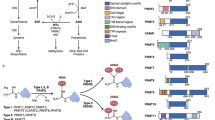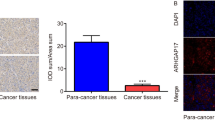Abstract
Cytochrome P450 2C9 (CYP2C9) is involved in the metabolism of cancer drugs and exogenous carcinogens. In our study, CYP2C9 was downregulated in multiple cohorts of human esophageal squamous cell carcinoma (ESCC). Until now, its role and epigenetic regulation of CYP2C9 repression in ESCC remain poorly understood. CYP2C9 repression in collected ESCC patient tumor tissues was demonstrated by RT-qPCR and Western blot. The histone acetylation level was carried out by the treatment of histone deacetylase inhibitor TSA and RNA interference. Epigenetic analysis revealed that the increased expression of CYP2C9 in KYSE-150 and TE1 cells was characterized by inhibition of HDAC8 and HDAC1, respectively. TSA decreased the levels of HDAC occupancy around CYP2C9 promoter region greatly. Overexpression of CYP2C9 reduced the invasion and migration of ESCC cells.





Similar content being viewed by others
Data availability
The datasets obtained and analyzed during the current study were available from the corresponding authors in a reasonable request.
Abbreviations
- ESCC:
-
Esophageal squamous cell carcinoma
- CYP2C9:
-
Cytochrome P450 2C9
- HDAC:
-
Histone deacetylase
- siRNAs:
-
Small interfering RNAs
- FCM:
-
Flow Cytometry
References
Bray F, Ferlay J, Soerjomataram I, Siegel RL, Torre LA, Jemal A (2018) Global cancer statistics 2018: GLOBOCAN estimates of incidence and mortality worldwide for 36 cancers in 185 countries. CA Cancer J Clin 68(6):394–424
Chen W, Zheng R, Baade PD, Zhang S, Zeng H, Bray F, Jemal A, Yu XQ, He J (2015) Cancer statistics in China. CA Cancer J Clin 66(2):115–132
Fujita H, Kakegawa T, Yamana H, Shima I, Toh Y, Tomita Y, Fujii T, Yamasaki K, Higaki K, Noake T, Ishibashi N, Mizutani K (1995) Mortality and morbidity rates, postoperative course, quality of life, and prognosis after extended radical lymphadenectomy for esophageal cancer. Comparison of three-field lymphadenectomy with two-field lymphadenectomy. Ann Surg 222(5):654–662
Gonzalez FJ, Gelboin HV (1994) Role of human cytochromes P450 in the metabolic activation of chemical carcinogens and toxins. Drug Metab Rev 26(1–2):165–183
Jiang F, Chen L, Yang YC, Wang XM, Wang RY, Li L, Wen W, Chang YX, Chen CY, Tang J, Liu G, Huang WT, Xu L, Wang HY (2015) CYP3A5 functions as a tumor suppressor in hepatocellular carcinoma by regulating mTORC2/Akt signaling. Cancer Res 75(7):1470–1481
Rodriguez-Antona C, Gomez A, Karlgren M, Sim SC, Ingelman-Sundberg M (2010) Molecular genetics and epigenetics of the cytochrome P450 gene family and its relevance for cancer risk and treatment. Hum Genet 127(1):1–17
Yokose T, Doy M, Taniguchi T, Shimada T, Kakiki M, Matsuzaki Y, Mukai K (1999) Immunohistochemical study of cytochrome P450 2C and 3A in human non-neoplastic and neoplastic tissues. Virchows Arch 434(5):401–411
Lee SJ, Usmani KA, Chanas B, Ghanayem B, Xi T, Hodgson E, Mohrenweiser HW, Goldstein JA (2003) Genetic findings and functional studies of human CYP3A5 single nucleotide polymorphisms in different ethnic groups. Pharmacogenetics 13(8):461–472
Lamba JK, Lin YS, Schuetz EG, Thummel KE (2002) Genetic contribution to variable human CYP3A-mediated metabolism. Adv Drug Deliv Rev 54(10):1271–1294
Schmelzle M, Dizdar L, Matthaei H, Baldus SE, Wolters J, Lindenlauf N, Bruns I, Cadeddu RP, Kröpil F, Topp SA, Esch JS 2nd, Eisenberger CF, Knoefel WT, Stoecklein NH (2011) Esophageal cancer proliferation is mediated by cytochrome P450 2C9 (CYP2C9). Prostaglandins Other Lipid Mediat 94(1–2):25–33
Jiang JG, Chen CL, Card JW, Yang S, Chen JX, Fu XN, Ning YG, Xiao X, Zeldin D, Wang DW (2005) Cytochrome P450 2J2 promotes the neoplastic phenotype of carcinoma cells and is up-regulated in human tumors. Cancer Res 65(11):4707–4715
Jones PA, Baylin SB (2002) The fundamental role of epigenetic events in cancer. Nat Rev Genet 3(6):415–428
Esteller M (2008) Epigenetics in cancer. N Engl J Med 358(11):1148–1159
Dawson MA, Kouzarides T (2012) Cancer epigenetics: from mechanism to therapy. Cell 150(1):12–27
Narimatsu S, Yonemoto R, Saito K, Takaya K, Kumamoto T, Ishikawa T, Asanuma M, Funada M, Kiryu K, Naito S, Yoshida Y, Yamamoto S, Hanioka N (2006) Oxidative metabolism of 5-methoxy-N, N-diisopropyltryptamine (Foxy) by human liver microsomes and recombinant cytochrome P450 enzymes. Biochem Pharmacol 71(9):1377–1385
Codd R, Braich N, Liu J, Soe CZ, Pakchung AA (2009) Zn(II)-dependent histone deacetylase inhibitors: suberoylanilide hydroxamic acid and trichostatin A. Int J Biochem Cell Biol 41(4):736–739
Guo Z, Johnson V, Barrera J, Porras M, Hinojosa D, Hernández I, McGarrah P, Potter DA (2018) Targeting cytochrome P450-dependent cancer cell mitochondria: cancer associated CYPs and where to find them. Cancer Metastasis Rev 37(2–3):409–423
Osanai M, Sawada N, Lee GH (2010) Oncogenic and cell survival properties of the retinoic acid metabolizing enzyme, CYP26A1. Oncogene 29(8):1135–1144
Yu Z, Tian X, Peng Y, Sun Z, Wang C, Tang N, Li B, Jian Y, Wang W, Huo X, Ma X (2018) Mitochondrial cytochrome P450 (CYP) 1B1 is responsible for melatonin-induced apoptosis in neural cancer cells. J Pineal Res 65(1):e12478
Zhou C, Huang J, Li Q, Zhan C, Xu X, Zhang X, Ai D, Zhu Y, Wen Z, Wang D (2018) CYP2J2-derived EETs attenuated ethanol-induced myocardial dysfunction through inducing autophagy and reducing apoptosis. Free Radic Biol Med 117:168–179
Garcia-Martin E, Martinez C, Ladero JM, Gamito FJ, Rodriguez-Lescure A, Agundez JA (2002) Influence of cytochrome P450 CYP2C9 genotypes in lung cancer risk. Cancer Lett 180(1):41–46
Sausville LN, Gangadhariah MH, Chiusa M, Mei S, Wei S, Zent R, Luther J, Shuey M, Capdevila J, Falck J, Guengerich F, Williams S, Pozzi A (2018) The cytochrome P450 slow metabolizers CYP2C9*2 and CYP2C9*3 directly regulate tumorigenesis via reduced epoxyeicosatrienoic acid production. Cancer Res 78(17):4865–4877
Samowitz WS, Wolff RK, Curtin K, Sweeney C, Ma KN, Andersen K, Levin TR, Slattery ML (2006) Interactions between CYP2C9 and UGT1A6 polymorphisms and nonsteroidal anti-inflammatory drugs in colorectal cancer prevention. Clin Gastroenterol Hepatol 4(7):894–901
Bergheim I, Wolfgarten E, Bollschweiler E, Hölscher A, Bode C, Parlesak A (2007) Cytochrome P450 levels are altered in patients with esophageal squamous-cell carcinoma. World J Gastroenterol 13(7):997–1002
Makia N, Surapureddi S, Monostory K, Prough R, Goldstein J (2014) Regulation of human CYP2C9 expression by electrophilic stress involves activator protein 1 activation and dna looping. Mol Pharmacol 86(2):125–137
Sahi J, Shord S, Lindley C, Ferguson S, LeCluyse E (2009) Regulation of cytochrome P450 2C9 expression in primary cultures of human hepatocytes. J Biochem Mol Toxicol 23(1):43–58
Chaloin S, Daujat M, Pascussi J, Garcia L, Vilarem M, Maurel P (2002) Transcriptional regulation of CYP2C9 gene role of glucocorticoid receptor and constitutive androstane receptor. J Biol Chem 277(1):209–217
Chen Y, Kissling G, Negishi M, Goldstein J (2005) The nuclear receptors constitutive androstane receptor and pregnane X receptor cross-talk with hepatic nuclear factor 4alpha to synergistically activate the human CYP2C9 promoter. Pharmacol Exp Ther 314(3):1125–1133
Ogiwara H, Sasaki M, Mitachi T, Oike T, Higuchi S, Tominaga Y, Kohno T (2016) Targeting p300 addiction in CBP-deficient cancers causes synthetic lethality by apoptotic cell death due to abrogation of MYC expression. Cancer Discov 6(4):430–445
Zhu Q, Yu L, Qin Z, Chen L, Hu H, Zheng X, Zeng S (2019) Regulation of OCT2 transcriptional repression by histone acetylation in renal cell carcinoma. Epigenetics 14(8):791–803
Yang W, Hsu C, Hsu T, Liou J, Chang K, Chen P, Liu J, Yang S, Wang J, Yeh S, Chen R, Chang W, Chuang J (2020) Increased activation of HDAC1/2/6 and Sp1 underlies therapeutic resistance and tumor growth in glioblastoma. Neuro Oncol. https://doi.org/10.1093/neuonc/noaa103
Al-Dhfyan A, Alhoshani A, Korashy H (2017) Aryl Hydrocarbon receptor/cytochrome P450 1A1 pathway mediates breast cancer stem cells expansion through PTEN inhibition and β-catenin and Akt activation. Mol Cancer 16(1):14
Funding
This work was financially supported by National Natural Science Foundation of China (No. 81702801), Hangzhou City Scientific Technology Research Foundation of Zhejiang Province, China (No. 20180533B67), China Postdoctoral Science Foundation (No. 2020M680130), Zhejiang Provincial Natural Sciences Foundation of China (No. LY18H310012), and Zhejiang Provincial Natural Sciences Foundation of China (No. LGF19H310001).
Author information
Authors and Affiliations
Contributions
ZJ and XZ performed most of the experiments and wrote the manuscript. MJ and WW wrote and revised a part of the manuscript. LQ and LY performed Western blotting and qRT-PCR analysis. YH designed and supervised the study.
Corresponding author
Ethics declarations
Conflict of interest
The authors declare that they have no potential or actual conflicts of interest.
Ethical approval
This project was approved by the Institutional Review Board of Hangzhou Cancer Hospital (Permit Number: HZCH-2016-02).
Additional information
Publisher's Note
Springer Nature remains neutral with regard to jurisdictional claims in published maps and institutional affiliations.
Supplementary Information
Below is the link to the electronic supplementary material.
Rights and permissions
About this article
Cite this article
Jiang, Z., Zheng, X., Wang, W. et al. CYP2C9 inhibits the invasion and migration of esophageal squamous cell carcinoma via downregulation of HDAC. Mol Cell Biochem 476, 2011–2020 (2021). https://doi.org/10.1007/s11010-021-04050-3
Received:
Accepted:
Published:
Issue Date:
DOI: https://doi.org/10.1007/s11010-021-04050-3




